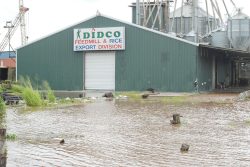Dear Editor,
I could recall that a letter writer, Mr Imtiaz Bacchus, questioned the health issues of a GWI well located in the cemetery at Fyrish Village which provides drinking water for thousands of residents in the surrounding areas.
As far as I could recall there was no comment offered by GWI on the issues raised by Mr Bacchus. I found this to be very irresponsible. We are talking about the health of the people and the head of GWI is a doctor by profession and of all people should have proffered an explanation to allay the concerns of the residents. Why was there no explanation to allay the fears of the residents?
I was shocked that experts at GWI and the health authorities would have allowed this risk to residents’ health to be ignored. I wish to state some findings of a research paper. “In the process of decomposition of a human body, 0.4–0.6 litres of leachate is produced per 1 kg of body weight. The leachate contains pathogenic bacteria and viruses that may contaminate the groundwater and cause disease when it is used for drinking. So far, this topic has been investigated in several regions of the world (mainly Brazil, Australia, the Republic of South Africa, Portugal, the United Kingdom and Poland). However, recently more and more attention has been focused on this issue. A thorough study was done and the results of investigations related to the impact of cemeteries on groundwater bacteriology and virology are well-documented. The contaminants coming from the body can include chemical substances applied in chemotherapy and embalming processes (e.g., arsenic, formaldehyde and methanol), makeup (e.g., cosmetics, pigments and chemical compounds), as well as various additional items, such as fillings, cardiac pacemakers, paints, varnishes, metal hardware elements, iron nails, etc. These leachates also contain microorganisms that may pollute substrates, surface water and groundwater.
“The microorganisms chiefly include bacteria, viruses, intestinal fungi and protozoa. They can also originate from other sources, e.g., animals, soil, water and the atmosphere… some microorganisms can survive even up to 5 years and, in this time, they can migrate and reach the groundwater.” (http://jwh.iwaponline.com/content/ppiwajwh/13/2/285.full.pdf)
The same study went on to state that, “It is worth emphasizing that bacteria transported by water, like those of the genus Shigella, as well as rotaviruses and protozoans of the genera Entamoeba and Giardia, often cause asymptomatic or serious infections with high mortality rates, particularly among children… cemeteries may have large adverse impacts on groundwater and can be a source of dangerous infectious diseases.”
It must be noted that the Fyrish Cemetery is located just across the twelve foot dam where the residents live, so it poses a high risk during flooding.
The study also stated that the health hazards from cemeteries are nothing new and caught the attention of scientists at the end of the nineteenth century. In 1879, the French Society for Hospital Hygiene noticed the relationship between typhoid fever and groundwater contaminated by leachates from a cemetery in Paris. Since these findings go back a long time it befuddles the mind why this well should be located in a cemetery when there is an abundance of land nearby.
The study also revealed “the large influence of climatic conditions on the bacteriological contamination of the groundwater and most researchers express the opinion that a warmer and moister climate is the principal factor in significant contamination of the environment …”
According to the World Health Organization “Human or animal remains must not be buried within 250 metres of any well, borehole or spring from which a potable water supply is drawn”. This makes the location of the well at Fyrish highly questionable.
In conclusion, the residents must know the rationale behind the location such as the type of soil and its permeability to permit leaching and seepage. The questions are how far the graves are above the water table, and the effects of flooding in the cemetery on the percolation of the groundwater. However, it must be borne in mind that the location of the water well in a cemetery whether or not it satisfies the criteria of suitability will do nothing to alleviate the psychological fear which eats the minds of the residents, causing many of them to buy water for drinking purposes.
Yours faithfully,
Haseef Yusuf
Councillor
RDC Region 6









